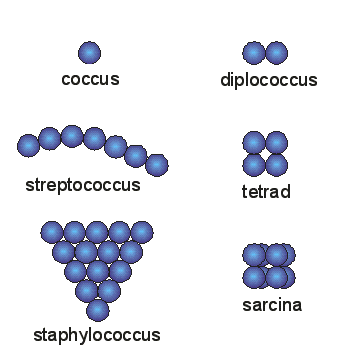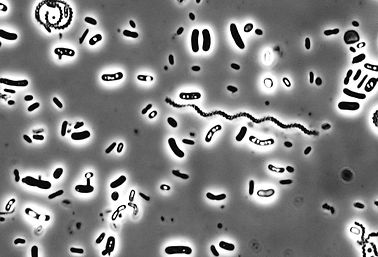
 Coccusspherical or oval bacteria with different arrangements. (T-9, I-22) |  Bacillusrod-shaped bacteria. (T-9, I-23) |
|---|---|
 Spirillumcork-screw shaped bacteria. (T-10, I-24) |  RickettsiaUnique bacteria that is incapable of surviving without a host. Usually a parasite of arthropods such as lice and ticks. (T-10, T-11, I-24) |
 MycoplasmaUnique bacteria that lacks a cell wall; this is consider to be a protective mechanism against antibiotics. (T-10, I-25) |
Bacteria















WHAT ARE BACTERIA?
TYPES OF BACTERIA
Bacteria (plural), consists of a colony of bacterium (singular). They are prokaryotic, single-celled organisms that can generally be seen with a low-powered microscope. They are discovered to be over three billions years old. Through these times, they have learned to evolve and better themselves into stronger organisms. (T-8)
Bacteria can be either beneficial or harmful to humans, animals, and plants.
GRAM POSITIVE VS. GRAM NEGATIVE


Bacteria carry only a single circular molecule of DNA, and sometimes plasmids as well; these allow the bacteria to become antibiotic resistant. They reproduce by binary fission, and split into two,often identical, cells. However, mutations do occurs when there is a mistake during the division. A mutated offspring means the organism has increased its variety of traits. This is how bacteria learn to change to adapt to antibiotics. They can also gain genetic material from other bacteria, viruses, or plants. (T-8, T-13)
Bacteria can be further grouped by whether they are gram positive or gram negative.
There are five types of bacteria classified by shapes.

Above displayed is bacteria in activated sludge from a wastewater treatment plant. (I-29)
Gram negative bacteria, because of their additional outer membrane, is more antibiotic resistant. 90-95% of these bacteria are pathogenic, making it difficult to eliminate them. Gram positive bacteria are mostly non-pathogenic.

